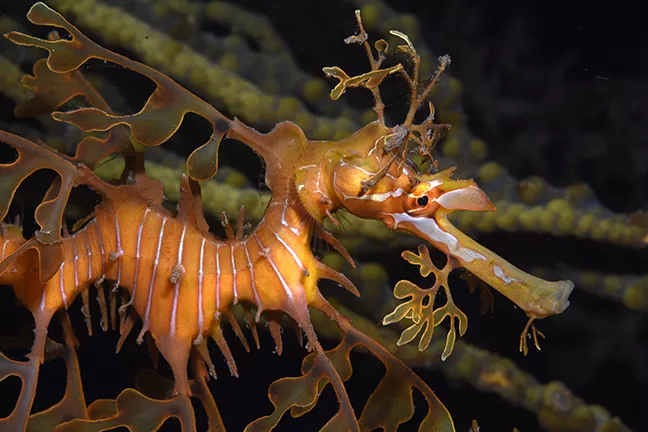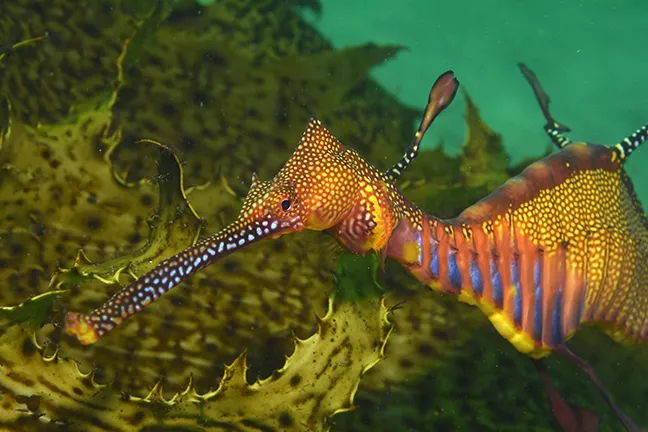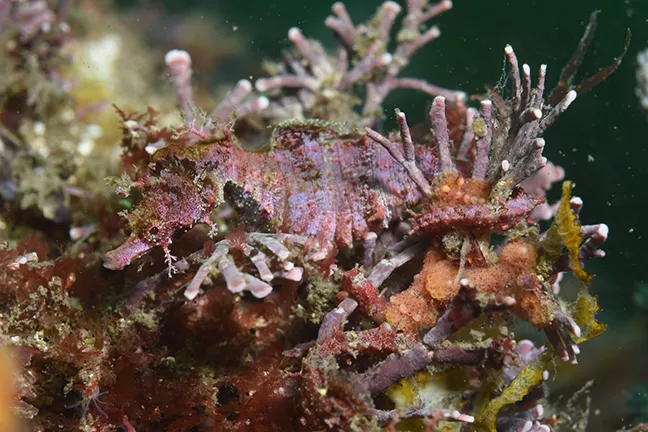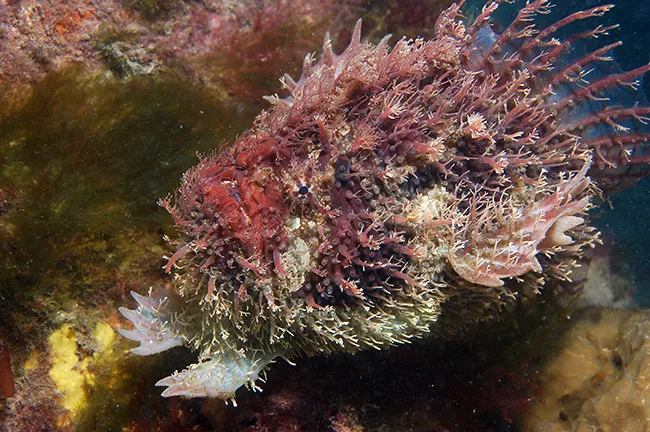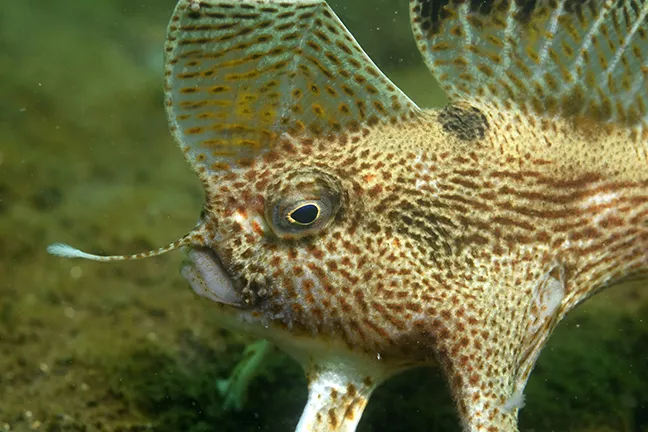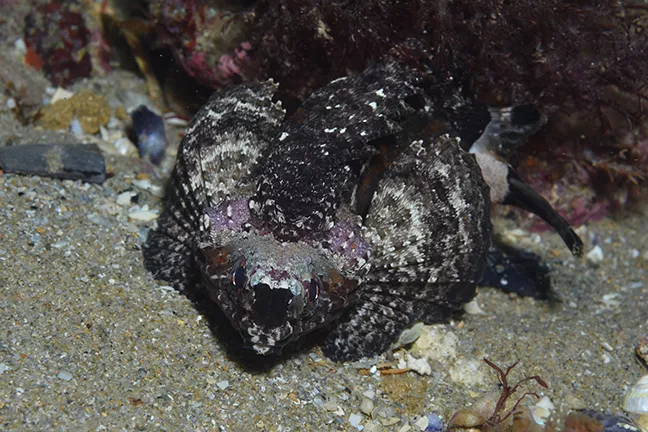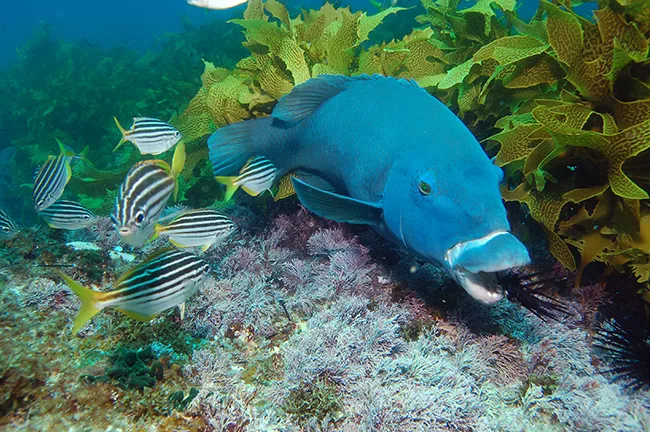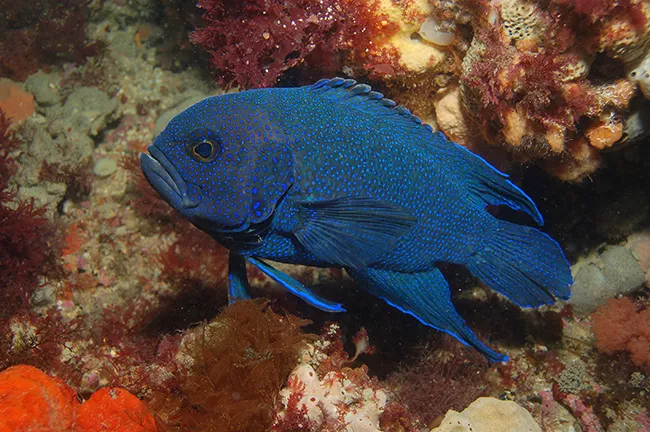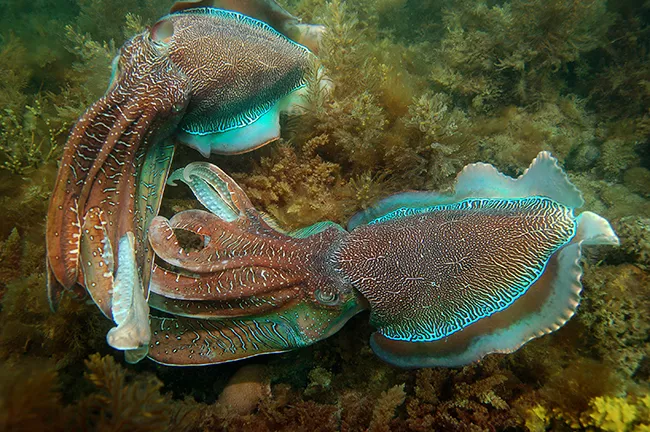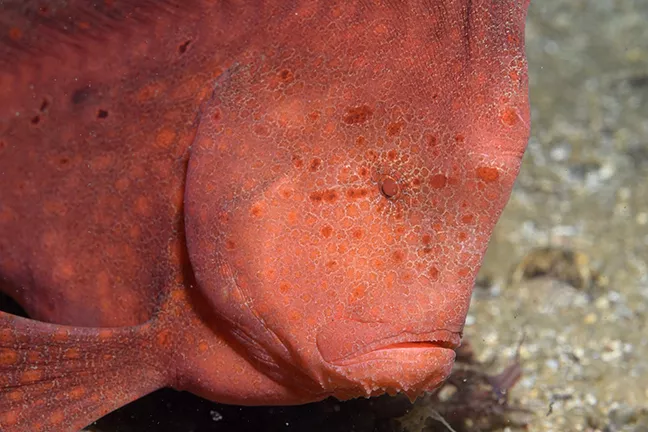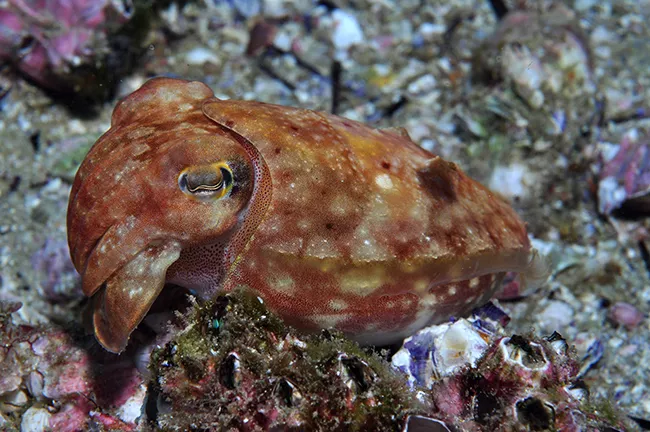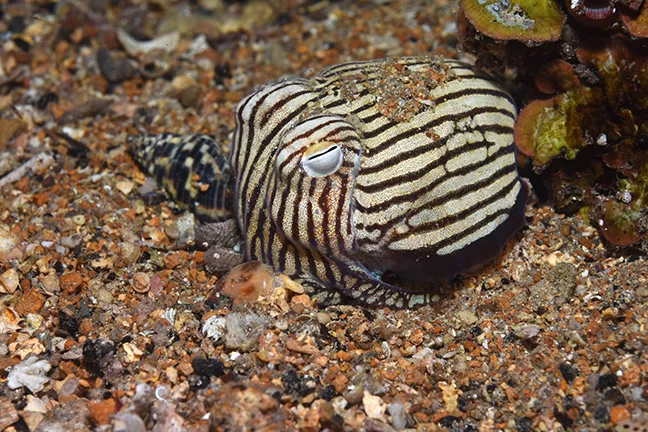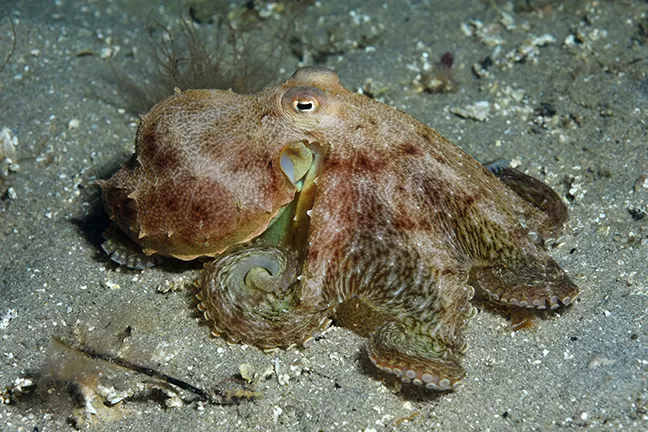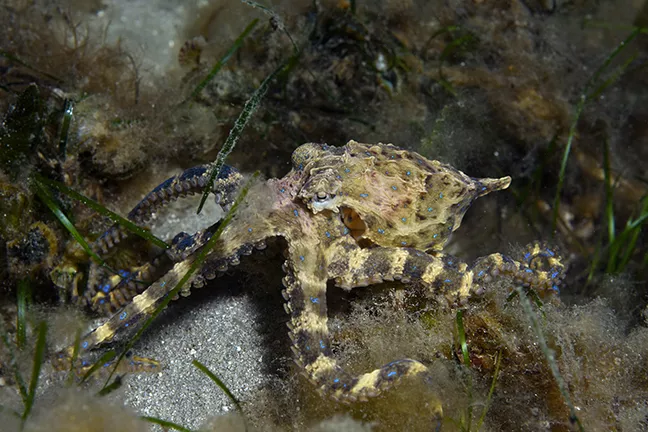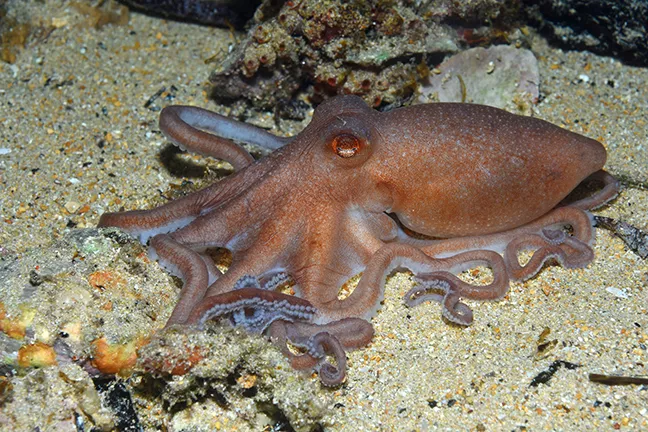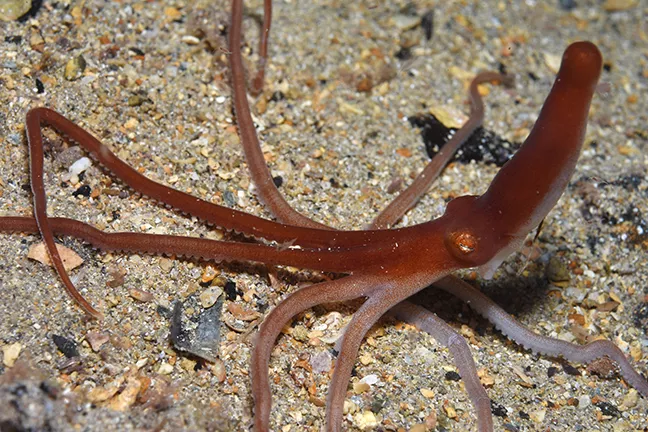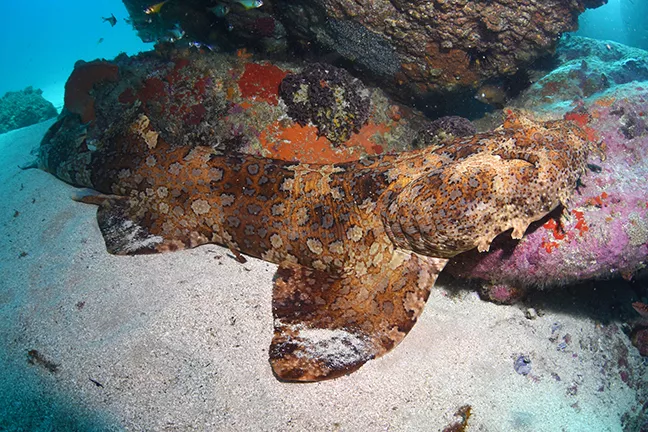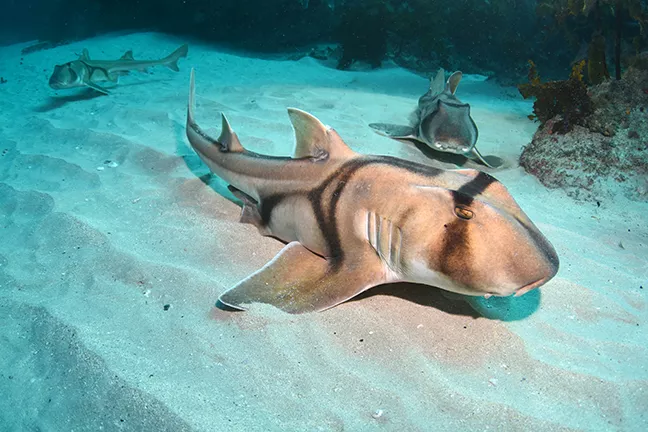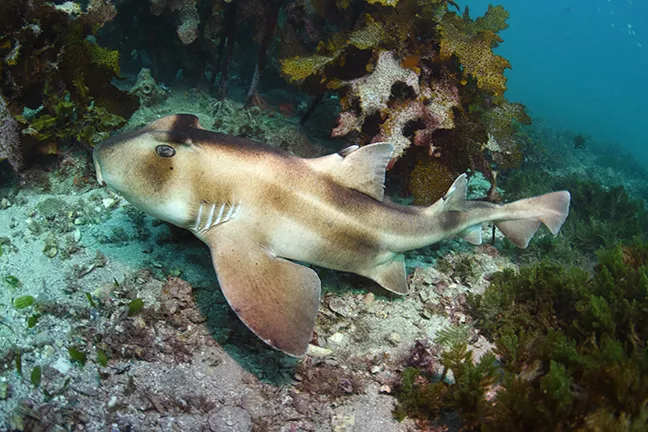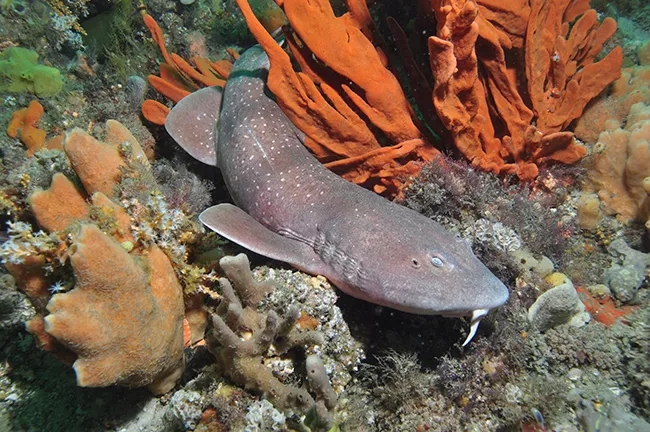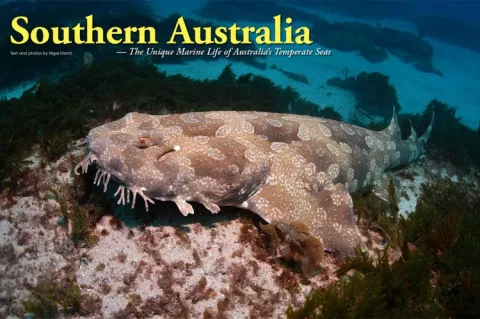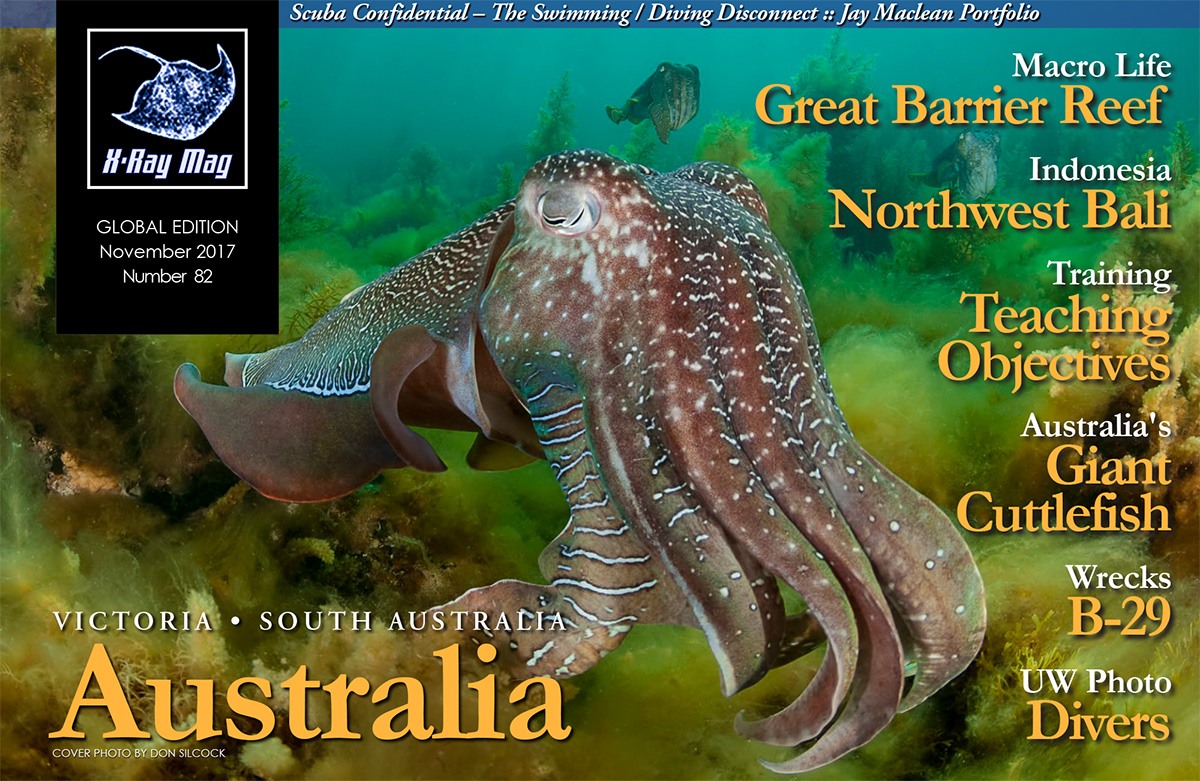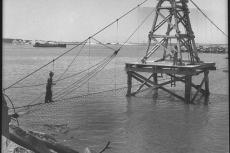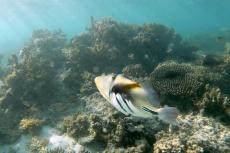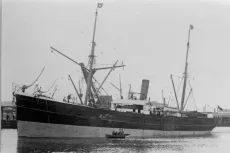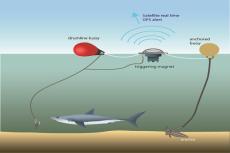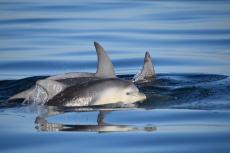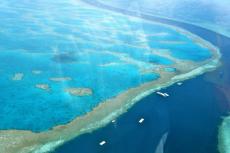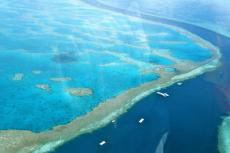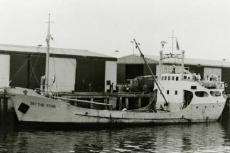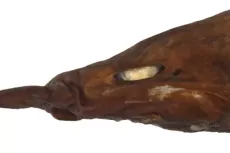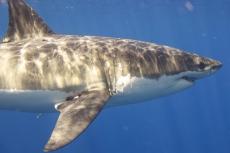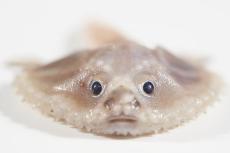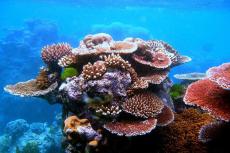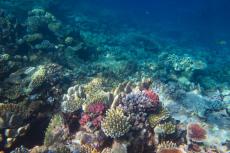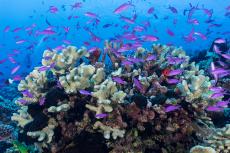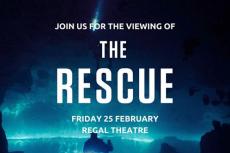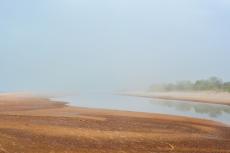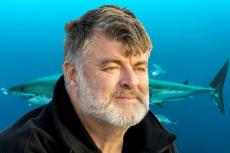Most divers heading to Australia make a beeline straight to the Great Barrier Reef. And while this wonder of the world has some amazing dive sites and marine life (and is still very much alive, contrary to claims in the media), it does not have many species that are uniquely Australian, as most of its tropical species are common throughout the Indo-Pacific region. To see Australia’s most unique marine life, you have to travel south of the Great Barrier Reef and dive into the country’s cooler temperate seas, as this is the realm of giant cuttlefish, PJs, leafies, weedies, wobbies, handfish, blue gropers, goblinfish and many other wonderful endemic creatures.
Contributed by
Factfile
Nigel Marsh is a widely published Australian underwater photographer and writer based in Brisbane.
Over the years, he has produced a number of books for children and divers—his latest being Underwater Australia and Muck Diving for New Holland Publishers.
For more information, please visit: NigelMarshPhotography.com.
Australia’s temperate waters are found in an area from Sydney to Perth. This region encapsulates southern New South Wales, Victoria, Tasmania, South Australia and southern Western Australia and has numerous dive shops and charter boats taking divers to the best local sites. Divers exploring this cooler region of Australia will discover a wonderful mix of boat and shore dives on rocky reefs, jetties and piers, shipwrecks, sponge gardens and kelp beds. However, as great as the dive sites are in these temperate seas, the main reason this area is so special is its magnificent marine life, with most species found nowhere else on earth.
There be dragons and wild horses
Australia’s temperate seas are one of the best places in the world to encounter members of the Syngnathidae family, with numerous seahorses, pipefish and pipehorses to be seen. Of these wonderful creatures, the most popular and the one that lures many divers to explore Australia’s temperate seas is the spectacular leafy seadragon (Phycodurus eques), commonly called the "leafy."
Leafy seadragon. Only found off western Victoria, South Australia and southern Western Australia, this incredible fish is highly sought after by underwater photographers. Although growing to a length of 35cm and a slow swimmer, the leafy is a very difficult fish to find without assistance from an experienced local guide. Their leaf-like appendages and yellowish colouration help to camouflage them amongst seagrass and kelp. But, even when found, if you take your eyes off the animal for a second, you can quickly lose it. Leafies are most commonly seen in South Australia, with spots like Rapid Bay Jetty and Tumby Bay Jetty being reliable places to encounter one or more.
Weedy seadragon. There are actually three species of seadragons found in Australian waters, but the only other species commonly seen by divers is the weedy seadragon (Phyllopteryx taeniolatus). This brilliant multi-coloured fish is found throughout Australia’s temperate zone and grows to a length of 45cm. Found around sponge gardens, seagrasses and kelp beds, weedies (as they are commonly called) are a little easier to spot than their leafy cousins. Their colouration also varies from state to state: The ones off New South Wales display bright pinks and yellows; the ones off Tasmania have vivid reds; while the ones off Victoria tend to have less colour. Weedies can be seen at numerous dive sites, with Kurnell off Sydney, Flinders and Portsea Piers off Melbourne, and Eaglehawk Neck off Tasmania all having a good population.
Watching seadragons is always a delight, especially when they are busy feeding, sucking up tiny mysid shrimps. Photographing them can sometimes be a little tricky, as they do not like the attention and regularly turn away from the camera. Seadragons may have a hard exoskeleton, but they are actually very delicate and fragile creatures, and should never be touched or handled. Photographers are also asked to limit the number of photos, as the flash can stress them.
White’s seahorse. Australia is blessed with the world’s greatest variety of seahorses, pipefishes and pipehorses, with these cute little critters abundant in southern waters. Sydney is home to a great number of seahorses, with the most common species being the White’s seahorse (Hippocampus whitei). This species is encountered at many sheltered Sydney dive sites, even in Sydney Harbour, clinging to sponges, kelp, ropes, netting and just about anything else.
Big-belly seahorse. The world’s largest seahorse species, the big-belly seahorse (Hippocampus abdominalis), is also common in southern waters. Growing to a length of 35cm, and sporting a rather large stomach, the big-belly seahorse is a creature that is hard to miss. This species is particularly common under jetties and piers, with Melbourne’s Port Phillip Bay being a great place to see this lovely seahorse. Another seahorse seen around Melbourne is the shorthead seahorse (Hippocampus breviceps). This small species is often difficult to find, as it likes to hide amongst seaweeds.
Sydney pygmy pipehorse. Another unique animal from this family to look out for off Sydney is the Sydney pygmy pipehorse (Idiotropiscis lumnitzeri). This tiny creature is a cross between a seahorse and pipefish, and is hard to spot as it clings onto similarly coloured algae. Only discovered in 1997 by an observant Sydney diver, this wonderful little fish is found over a very small range and a local guide is very handy in pointing them out. The best place to see the Sydney pygmy pipehorse is Bare Island in Botany Bay; the last time I dived this site, I found three clinging to one patch of algae.
Weird Aussie fish
Almost all the fish divers encounter in Australia’s temperate seas are endemic to this region. While the common species in families like the leatherjackets, morwongs, weedfishes, boarfishes, wirrahs, cowfishes, seaperches and trumpeters are fun to watch and photograph, southern Australia also has many weird fish that are very special.
Frogfish. Frogfishes are usually associated with tropical waters, but a great variety of these very photogenic creatures are also found in Australia’s temperate seas. Many of these endemic frogfishes are small and very cryptic, so they can be difficult to find. However, one member of the family is large and well worth looking for: the tasselled frogfish (Rhycherus filamentosus). Covered in branching filaments, the tasselled frogfish is a master of camouflage and often challenging to spot on similar looking backgrounds. This species is often found on jetty pylons in Melbourne’s Port Phillip Bay and also under jetties on South Australia’s Yorke Peninsula. Having a local guide beside you is recommended to point out this spectacular fish that grows to a length of 23cm.
Handfish. A unique family of fish only found in southern Australia are the handfishes. Closely related to the frogfish, these fishes also have a head lure and walk on their fins, but have more prominent fins. All fourteen members of the handfish family are very rare, and also threatened with extinction due to habitat loss and invasive species. However, there is one member of the family that can sometimes be found at a few selected dive sites off Hobart: the beautiful spotted handfish (Brachionichthys hirsutus). This strange fish grows to 12cm in length and is found on sandy and muddy bottoms where it feeds on small worms and crustaceans. When alarmed, the spotted handfish stands on its pectoral fins and flares its dorsal fins to make itself look bigger. Seek local advice to see this rare fish as they are very difficult to find.
Goblinfish. Diving the cool waters of southern Australia, divers will encounter members of the scorpionfish family, but the one underwater photographers most seek is the bizarre goblinfish (Glyptauchen panduratus). This very strange fish has a blood-red ring around its pupils and a small flattened head on the end of an extended neck. When threatened, the goblinfish fans its feather-like pectoral fins, which makes it look like a chicken. The goblinfish grows to 20cm in length and is rarely seen by divers, as it is nocturnal and likes to hide under seaweed and rocks. However, they are occasionally seen under piers in Melbourne’s Port Phillip Bay.
Prowfish. Another family of fish only found in southern Australia are the prowfish. These strange fishes lack scales, and instead have leather-like skin, which they regularly moult. The most common member of this family that divers encounter is the peculiar Red Indian fish (Pataecus fronto). Only found off New South Wales, the Red Indian fish looks like a red sponge and is generally found in sponge gardens sitting next to red sponges. They grow to 35cm in length and are often found in pairs, so if you can find one, there is generally another one nearby. Red Indian fishes generally do not like to swim, and move across the bottom by rocking from side to side, pretending to be a piece of broken sponge. The two best spots to see the Red Indian fish are on the rocky reefs off Sydney and Jervis Bay.
Cute blue companions and bold devils
Blue groper wrasse. The wrasse family is very well represented in Australian waters, with dozens of these small colourful fish seen darting around sponge gardens and rocky reefs. But the two largest members of this family are a delight to dive with: the eastern blue groper wrasse (Achoerodus viridis) and the western blue groper wrasse (Achoerodus gouldii). Both are simply called blue gropers, and while the western variety is larger, growing to 1.6m in length, the smaller eastern variety is far more friendly. Found at dive sites throughout New South Wales, these cheeky blue fish follow divers around like loyal puppies, expecting a free feed of broken-up sea urchin. They can be very persistent, and it is not unusual to be taking a photograph and having a metre-long blue groper nudging you for attention.
Blue devils. Other blue fish to keep an eye out for in Australia are the blue devils. This family contains several members, but the two most spectacular specimens are the eastern blue devil (Paraplesiops bleekeri) and the southern blue devil (Paraplesiops meleagris). These striking fish, with their vivid blue spots and colourful markings, grow to 40cm in length and are found on rocky reefs. They like to shelter in caves, but are often curious of divers and will venture close to inspect an intruder. The southern blue devil is very widespread, found from Melbourne to Perth, and commonly seen at many dive sites while the eastern blue devil is only found off New South Wales, with Jervis Bay and Sydney being two of the best spots to encounter one.
Tangling with tentacles
Australia’s temperate waters are a great place to see invertebrate species. In this area, nudibranchs, sea stars, sea spiders, shrimps, crabs, shellfish and flatworms are common. However, divers will also find Australia home to the greatest collection of cephalopods on the planet. Octopus, squid and cuttlefish are common around Australia, with the great majority of southern species endemic.
Giant cuttlefish. One member of this family that already attracts underwater photographers Down Under is the wonderful giant cuttlefish (Sepia apama). Growing to a length of over 1m, these huge cephalopods are found throughout Australia’s temperate seas. Giant cuttlefish are often curious of divers, and have been known to follow a diver around a dive site, and grab torches, gauges and cameras. While giant cuttlefish can be seen anywhere across their range, Whyalla in South Australia is the best place to observe them. Each winter, thousands of giant cuttlefish gather on the rocky reefs near Whyalla to breed, the only mass breeding of any cuttlefish species in the world.
Reaper cuttlefish. A number of smaller cuttlefish species are seen across southern Australia, including the reaper cuttlefish (Sepia mestus) in New South Wales. This cute little cuttlefish reaches a length of 15cm and is always a pretty pink or red colour. Found on rocky reefs and around sponge gardens, the reaper cuttlefish always makes for a great camera subject.
Striped pyjama squid. The most spectacular member of this family found in southern Australia would have to be the brilliant striped pyjama squid (Sepioloidea lineolata). A type of bottletail squid, this striking animal has bold black and white stripes and grows to 7cm in length. A nocturnal species, the striped pyjama squid hides under a layer of sand during the day and emerges at night to feed. One of the best places to see this wonderful critter is under Edithburgh Jetty in South Australia.
Octopus. Many divers head to muck diving sites like Lembeh to see the octopuses, but divers can see more species of octopus on a single night dive in southern Australia than in a month of diving at Lembeh. Two spectacular dive sites where divers will see abundant octopi are Edithburgh Jetty in South Australia and Blairgowrie Pier in Melbourne. Night dives at either of these sites will expose divers to a wide variety of octopus species. The most common species is the southern keeled octopus (Octopus berrima). This species generally lives in the sand, but will also take up residence in discarded cans. Also common are huge Maori octopi (Octopus maorum). This species has an arm span of over 3m and is often curious of divers, allowing for very close interaction.
A species that you may not want to get close to is the southern blue-ringed octopus (Hapalochlaena maculosa). These highly venomous octopi are often seen crawling across the bottom and fortunately they are not aggressive and prefer to avoid divers. More unusual octopus species that divers can encounter include the frilled pygmy octopus (Octopus supercilliosus), pale octopus (Octopus pallidus) and the southern white-spot octopus (Octopus bunurong). However, my favourite is the southern sand octopus (Octopus kaurna). This species resides in the sand during the day and is quite distinctive with its elongated head.
Shark-infested waters
Australia is a great place to see sharks, and if you believe the media, we have “shark-infested-waters.” Divers can encounter a variety of reef shark species in tropical waters, plus whale sharks off Ningaloo Reef, schools of grey nurse sharks off New South Wales and great white sharks off Port Lincoln. But the truly unique Aussie sharks are best viewed in temperate waters.
Wobbegong sharks. The most iconic family of sharks found in Australia waters would have to be the wobbegongs or wobbies. The wobbegong family contains twelve species, ten of which are found in Australian waters. The name "wobbegong" is an Australian Aboriginal word meaning “shaggy beard”, which is a great description of these unusual sharks that have a flattened body, colourful skin patterns and a fleshy beard around the head. Most wobbies inhabit tropical waters, but the two largest members of the family are found in southern Australia.
The spotted wobbegong (Orectolobus maculatus) is one of the most common shark species found in southern Australia. Growing to a length of 3.2m, these large sharks are found on rocky reefs and shipwrecks from southern Western Australia to southern Queensland. While they can turn up anywhere across their range, they are most abundant off New South Wales. These large ambush predators are easy to approach for photographs as they spend most of their time lazing on the bottom and waiting for prey to swim close enough to be snatched. But be warned, they don’t like to be harassed or cornered, and many a diver has been bitten by a stirred-up wobby.
The other wobby species that divers encounter in southern Australia is the banded wobbegong (Orectolobus halei). This species is found over much the same area as the spotted wobbegong, and reaching a length of 2.9m, it isn’t much smaller. This species prefers to shelter in caves and overhangs, so is not seen as often as the spotted wobbegong, which like to rest out in the open. Both banded and spotted wobbegongs can be seen at dive sites throughout New South Wales, with Jervis Bay and Sydney having a good population.
Port Jackson shark. The cutest shark divers can see in southern Australia is the Port Jackson shark (Heterodontus portusjacksoni). The largest member of the hornshark family, the Port Jackson shark (or "PJ"), grows to 1.6m in length and is found over the same area as the wobbies mentioned above. However, southern New South Wales is the best place to encounter them. These lovely sharks have tiny teeth and are very docile, happy to sit on the bottom while a diver inspects them closely. They also migrate with changes in water temperate, and while PJs can be seen year-round, their numbers increase dramatically at shallow rocky reefs over the winter months when they gather to breed. Wintertime off Sydney and Jervis Bay is a great time to see dozens of these wonderful sharks on a single dive.
Diverse species. Many other endemic shark species are seen in southern Australia, including the blind shark (Brachaelurus waddi), crested hornshark (Heterodontus galeatus), varied catshark (Parascyllium variolatum), draughtboard shark (Cephaloscyllium laticeps) and Australian angelshark (Squatina australis). These temperate waters are also home to a great variety of rays, with many endemic stingrays, stingarees, shovelnose rays, skates, electric rays and eagle rays to be seen. Finally, this area also has a good variety of marine mammals, with dolphins, whales and three species of seals found in southern Australia.
Diving conditions
The water may be cool in Australia’s temperate seas, but putting up with a little cold water is a small price to pay for encounters with incredible marine life. In reality, it is not freezing cold; over summer, this region varies from 17°C to 23°C (~63°F to 73°F), and in winter from 10°C to 15°C (~50°F to 59°F), so depending on where you dive, and at what time, you might need either a 5mm or 7mm semi-drysuit or a drysuit.
While most areas in southern Australia can be dived year-round, some areas are definitely better over summer and others better over winter. Always seek local advice before booking to find out when it is the best time to dive for weather conditions or certain creatures.
One final factor is visibility, and the good news is: It isn’t green. Temperate waters in many countries are generally loaded with plankton, algae and nutrients, which leaves the visibility dark and green. In southern Australia, you can get green water at times, but in general, the water is blue, and the average visibility varies from 5m to 15m. Visibility over 20m or 30m is not uncommon, especially when the weather is calm.
So, next time you are looking for a dive destination with something different and unique, why not treat yourself to the temperate waters of southern Australia? ■

